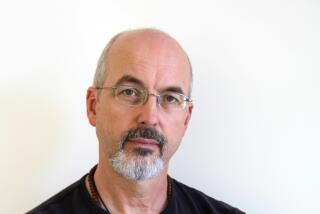Art Reviews : ‘Shooting at Ghosts’ Targets Memories Lost and Known
MISSION VIEJO — When we watch a movie--unless it’s by Robert Altman or one of the few other directors who go in for overlapping dialogue--we expect to hear clearly what everyone has to say and to see (or at least glimpse) all the action. Unlike real life, sounds generally are audible in a film only when they reinforce something happening on screen.
Visual artists making installations don’t feel constrained by these conventions. Sounds and voices--and video or still imagery--may overlap and undercut each other, evoke contrasting experiences and blur past and present, real and unreal, making it impossible to get a straightforward, linear sense of the piece as a whole.
In “The Earlier Known,” a sound-and-video installation by Stuart Bender and Angelo Funicelli, viewers must sort through four channels’ worth of imagery plus three layers of sound, including voices speaking several languages. The piece is part of the duo’s “Shooting at Ghosts” at the Saddleback College Art Gallery (through Oct. 13).
It isn’t that Bender and Funicelli are deliberately being obscure or don’t wish to communicate. Rather, they are engaged in combatting the myth of the single-track narrative cleanly yielding a single “truth.”
As in real life, viewers are obliged to process competing streams of information and draw on cultural and personal referents to give meaning to what they hear and see.
Using a combination of imagery and texts, two of the video screens juxtapose childhood recollections of unique moments (“the day they picked the only apricot on the tree”) and ritual actions occurring either in religious settings or at home (pouring tea, drying the dishes). Some of these rituals are shown both in Western and Asian settings. The silvery ping! of Asian temple bells occasionally underlines the ceremonial quality of this imagery.
Images of seemingly unrelated single objects on the other two video screens--a skate key, a shell, a crystal bibelot--are more elusive. Perhaps they are meant to evoke touchstones of memory, like Proust’s famous madeleine .
Several voices relate long stories in German and Italian. Meanwhile, a droning, intrusive English speaker describes in exhaustive detail the interior of a building. Perhaps he is meant to be a reminder that bald, measurable “facts” cannot substitute for the intuitive world of sense experience. In any case, for the English-speaking viewer at least, the most memorable “voices” are mute, rendered as fragmentary texts on a video screen.
Buried among more benign memories in these texts is someone recalling his father “climbing into (my) bed in the middle of the night and saying, ‘Be good like a good little girl.’ ” At other moments in the tape, we read about “the look on her face when he told her the truth” and “how his father’s skin felt like cold wax when they touched.”
Is this what it appears to be, a memory of sexual abuse? None of the visual imagery seems directly linked to it. But isn’t that the way terrible things occur, surrounded by the familiar, repeated actions that make up a life? And doesn’t a pattern of abuse itself become a ritual, however oppressive?
The remainder of the exhibition consists of three videos by Bender and Funicelli, whose work has been seen at such major venues as the New York Film and Video Festival and the American Film Institute in Los Angeles. Unfortunately, none has the open-ended yet compelling allusiveness of the installation. It’s as if the duo was wary, for some reason, of unleashing the more intuitive side of its vision and of using the fabulous electronic possibilities of media in more visceral ways.
“Seven Prophecies”--a sweeping treatment of good and evil, war and peace--is saddled with a cumbersome format, ponderous declamations, slow pacing and Funicelli’s off-putting atonal vocal score. (In accompanying notes for the exhibition, the artists make the peculiar claim that the soprano’s voice supplies “warmth” in contrast to the technological aspect of altered newsreel footage and an electronic soundtrack.)
An overly intellectualized, visually unimaginative view of conflict, “The Armed Man” is similarly disappointing--until the memorable final image of a man’s face eaten away by ants, which imperceptibly turns into a benign patch of bare earth.
The third video, “Anza Borrego”--a desert view that slowly metamorphoses into a cave--lacks sufficient visual contrast and seems irritatingly New Age-y in its twinkly sunshine finale.
* “Shooting at Ghosts,” an installation and three video works by Stuart Bender and Angelo Funicelli, continues through Oct. 13 at the Saddleback College Art Gallery, 28000 Marguerite Parkway, Mission Viejo. Monday from noon to 5 p.m. and 6 to 8 p.m.; Tuesday through Thursday from 10 a.m. to 5 p.m. Free. (714) 582-4924. *
SHORT STROKES: Contemporary Latino art from Southern California is the subject of “Mi Gente” at the Breeden Gallery in Orange (through Oct. 5). The better-known names (Patssi Valdez, Carlos Almaraz, Gronk) are represented by routine work, but paintings by relative newcomer Jose Lozano are a pleasant surprise. His work has steadily gained technical finish over the past few years without sacrificing an idiosyncratically skewed view of the world.
Lozano’s trademark deadpan male faces serve as a pale, wallpaper-like background for small, oddly delicate paintings of isolated, affectless people who have reverted to their childhood selves or are powerless in the clutches of nameless forces.
* Breeden Gallery, 141 S. Glassell St., Orange. 10 a.m. to 6 p.m. Monday through Thursday, 10 a.m. to 5 p.m. Friday and Saturday. Free. (714) 639-3398 .)
*
The ideal exhibition about the work of a theatrical set designer would follow one or two productions from start to finish using video clips and tapes as well as scale models, photographs and costumes. “Re-created World: The Collaborative Vision of Stage Design” at the Muckenthaler Cultural Center (through Oct. 2) is not that exhibition, but it does serve as an introduction to an intriguing field.
The show focuses on scale models of sets by Carey Wong for regional productions of Mozart’s “The Marriage of Figaro,” Donizetti’s “Don Pasquale” and other opera classics. Wall labels summarize the plots and offer brief comments about the different directorial concepts that result in a “Rigoletto” set in a grotto or in a Caribbean shack. Wong’s apparent predilection for linear, two-dimensional effects rather than architectural massing remains a constant.
* Muckenthaler Cultural Center, 1201 W. Malvern Ave., Fullerton. 10 a.m. to 4 p.m. Tuesday through Saturday, noon to 5 p.m. Sunday . Free. (714) 738-6595. )
More to Read
The biggest entertainment stories
Get our big stories about Hollywood, film, television, music, arts, culture and more right in your inbox as soon as they publish.
You may occasionally receive promotional content from the Los Angeles Times.










